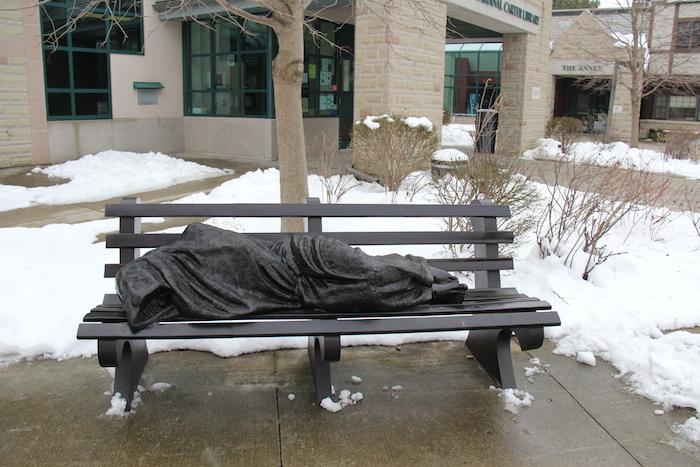Walking down Sixth Street, Gannon University students pass the usual landmarks like Nash Library without much thought to announcements like the signs marking the future location of St. Paul’s Episcopal Cathedral’s homeless Jesus Statue.
After the decision to commission the sculpture not 100 yards from the Waldron Campus Center, it has been subject to criticism regarding how effectively it will help the poor.
Michael DeSanctis, Ph.D., arranged last week’s roundtable discussion titled “Wonderful or Wasteful?” for students and the public to raise questions about these and other debates surrounding the cost and impact of the statue.
The Rev. John Downey, the dean of the cathedral, joined Gannon professors Parris Baker, Ph.D., the chair of the social work department, and Aaron Kerr, Ph.D., chair of the theology department Thursday to explain the role of art in Erie and its faith communities and serve as a board for answering questions.
DeSanctis started the discussion with a short presentation complete with animated effects like stacking pictures within the same slide and visually cutting out St. Peter’s Cathedral from New York City in an effort to show the importance of Christian art.
“We’re still temple builders,” DeSanctis said of cathedrals and the Gettysburg memorial. “We declare places sacred because of the blood sacrifice at that place.”
Downey said the cathedral decided on the statue because it was an alternate option when the space was deemed unsuitable as a winter homeless shelter, it is part of a lasting centennial project and it is public art.
The cathedral, which is in the process of raising the $33,000 needed to commission the statue, has recieved criticism despite 20 percent of the funds going to Erie’s winter shelters.
Downey said other criticisms are people saying Jesus should not be portrayed as a homeless person, the sum raised should just go straight to the poor and stereotypical social media negativity.
“It’s meant to be provocative like that,” Downey said. “‘What does help mean?’ is part of the ambiguity of the project.”
Baker said he likes the concept of the statue because it presents a paradox as a tool to present the invisible God and it should get people talking.
“It begins evangelical discussion,” Baker said. “That’s where it starts and that’s where it ends.”
Kerr said the statue is a reminder of our culture’s need to address the problem of failing to acknowledge the hungry person.
“I just think there’s so much need in Erie, and we’re not sharing the burden,” Kerr said.
Baker said students experience this problem in his diversity class when they play the part of a homeless person for an assignment in order to understand how we tend to treat the poor.
“What they want more than money is human touch,” Baker said.
The Catholic Herald said homeless people see the statue and recognize it as something like their Vietnam memorial. Downey said he hopes people in Erie will react similarly.
Taylor Wolff, a junior medical technology major, attended the discussion for class credit and said she wanted to hear more about the anticipated reaction from homeless people.
“They only spent a couple minutes on it,” Wolff said. “Sure they’re donating 20 percent, but that’s only like $7,000.
“It doesn’t make any sense to me.”
KELSEY GHERING
[email protected]








